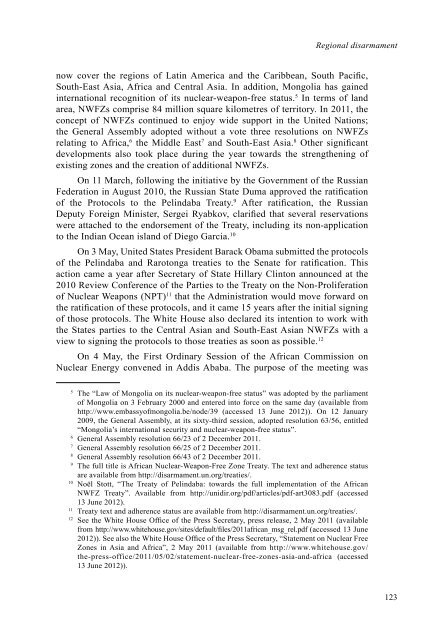DYB2011-Part-II-web
DYB2011-Part-II-web
DYB2011-Part-II-web
You also want an ePaper? Increase the reach of your titles
YUMPU automatically turns print PDFs into web optimized ePapers that Google loves.
Regional disarmament<br />
now cover the regions of Latin America and the Caribbean, South Pacific,<br />
South-East Asia, Africa and Central Asia. In addition, Mongolia has gained<br />
international recognition of its nuclear-weapon-free status. 5 In terms of land<br />
area, NWFZs comprise 84 million square kilometres of territory. In 2011, the<br />
concept of NWFZs continued to enjoy wide support in the United Nations;<br />
the General Assembly adopted without a vote three resolutions on NWFZs<br />
relating to Africa, 6 the Middle East7 and South-East Asia. 8 Other significant<br />
developments also took place during the year towards the strengthening of<br />
existing zones and the creation of additional NWFZs.<br />
On 11 March, following the initiative by the Government of the Russian<br />
Federation in August 2010, the Russian State Duma approved the ratification<br />
of the Protocols to the Pelindaba Treaty. 9 After ratification, the Russian<br />
Deputy Foreign Minister, Sergei Ryabkov, clarified that several reservations<br />
were attached to the endorsement of the Treaty, including its non-application<br />
to the Indian Ocean island of Diego Garcia. 10<br />
On 3 May, United States President Barack Obama submitted the protocols<br />
of the Pelindaba and Rarotonga treaties to the Senate for ratification. This<br />
action came a year after Secretary of State Hillary Clinton announced at the<br />
2010 Review Conference of the <strong>Part</strong>ies to the Treaty on the Non-Proliferation<br />
of Nuclear Weapons (NPT) 11 that the Administration would move forward on<br />
the ratification of these protocols, and it came 15 years after the initial signing<br />
of those protocols. The White House also declared its intention to work with<br />
the States parties to the Central Asian and South-East Asian NWFZs with a<br />
view to signing the protocols to those treaties as soon as possible. 12<br />
On 4 May, the First Ordinary Session of the African Commission on<br />
Nuclear Energy convened in Addis Ababa. The purpose of the meeting was<br />
5 The “Law of Mongolia on its nuclear-weapon-free status” was adopted by the parliament<br />
of Mongolia on 3 February 2000 and entered into force on the same day (available from<br />
http://www.embassyofmongolia.be/node/39 (accessed 13 June 2012)). On 12 January<br />
2009, the General Assembly, at its sixty-third session, adopted resolution 63/56, entitled<br />
“Mongolia’s international security and nuclear-weapon-free status”.<br />
6 General Assembly resolution 66/23 of 2 December 2011.<br />
7 General Assembly resolution 66/25 of 2 December 2011.<br />
8 General Assembly resolution 66/43 of 2 December 2011.<br />
9 The full title is African Nuclear-Weapon-Free Zone Treaty. The text and adherence status<br />
are available from http://disarmament.un.org/treaties/.<br />
10 Noël Stott, “The Treaty of Pelindaba: towards the full implementation of the African<br />
NWFZ Treaty”. Available from http://unidir.org/pdf/articles/pdf-art3083.pdf (accessed<br />
13 June 2012).<br />
11 Treaty text and adherence status are available from http://disarmament.un.org/treaties/.<br />
12 See the White House Office of the Press Secretary, press release, 2 May 2011 (available<br />
from http://www.whitehouse.gov/sites/default/files/2011african_msg_rel.pdf (accessed 13 June<br />
2012)). See also the White House Office of the Press Secretary, “Statement on Nuclear Free<br />
Zones in Asia and Africa”, 2 May 2011 (available from http://www.whitehouse.gov/<br />
the-press-office/2011/05/02/statement-nuclear-free-zones-asia-and-africa (accessed<br />
13 June 2012)).<br />
123


